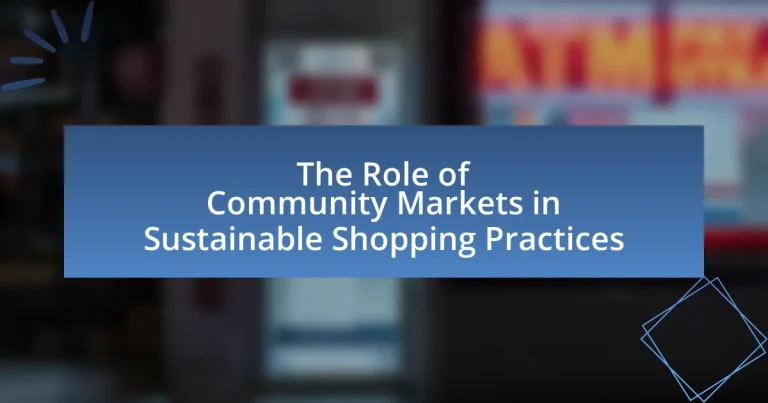Community markets are local marketplaces that facilitate the direct exchange of goods, emphasizing locally sourced, organic, and sustainable products. They play a crucial role in sustainable shopping practices by reducing carbon footprints, supporting local economies, and promoting biodiversity. The article explores how community markets contribute to sustainability, the types of products they offer, and their impact on local economies. It also addresses the challenges these markets face, including regulatory hurdles and consumer awareness, while highlighting strategies for consumers to maximize their impact through engagement and informed purchasing decisions.

What are Community Markets and Their Importance in Sustainable Shopping Practices?
Community markets are local marketplaces that facilitate the direct exchange of goods, often emphasizing locally sourced, organic, and sustainable products. Their importance in sustainable shopping practices lies in their ability to reduce carbon footprints by minimizing transportation distances, support local economies by empowering small-scale farmers and artisans, and promote biodiversity through the sale of diverse, seasonal produce. Research indicates that community markets can significantly enhance consumer awareness of sustainable practices, as they often provide educational resources and foster a sense of community engagement, which is crucial for promoting environmentally responsible consumption.
How do Community Markets contribute to sustainability?
Community markets contribute to sustainability by promoting local economies, reducing carbon footprints, and encouraging sustainable agricultural practices. These markets facilitate direct transactions between consumers and local producers, which minimizes transportation emissions and supports regional economies. For instance, a study by the USDA found that local food systems can reduce greenhouse gas emissions by up to 25% compared to conventional food distribution methods. Additionally, community markets often prioritize organic and sustainable farming methods, which helps preserve biodiversity and soil health. By fostering a connection between consumers and producers, community markets enhance awareness of sustainable practices and encourage responsible consumption.
What types of products are typically found in Community Markets?
Community markets typically feature locally sourced produce, handmade crafts, organic goods, and artisanal foods. These markets prioritize fresh fruits and vegetables, often grown by local farmers, which supports sustainable agriculture. Additionally, they offer products like baked goods, dairy items, and meats from nearby producers, fostering a direct connection between consumers and local suppliers. The presence of handmade crafts, such as jewelry and textiles, further emphasizes the unique offerings of community markets, promoting local artisans and reducing the carbon footprint associated with mass production.
How do Community Markets support local economies?
Community markets support local economies by facilitating direct transactions between local producers and consumers, which keeps money circulating within the community. This model enhances local economic resilience, as studies show that for every dollar spent at a community market, approximately 67 cents stays in the local economy compared to only 43 cents at national chains. Additionally, community markets create job opportunities and promote local entrepreneurship, further strengthening economic ties and fostering a sense of community.
Why are Community Markets considered a viable alternative to traditional retail?
Community markets are considered a viable alternative to traditional retail because they promote local economies and sustainable practices. These markets typically feature locally sourced products, reducing transportation emissions and supporting regional farmers and artisans. According to a study by the USDA, local food systems can significantly lower carbon footprints compared to conventional supply chains. Additionally, community markets foster social connections and community engagement, enhancing consumer trust and loyalty. This model not only addresses environmental concerns but also strengthens community ties, making it a compelling alternative to traditional retail.
What are the environmental benefits of shopping at Community Markets?
Shopping at Community Markets significantly reduces environmental impact by promoting local sourcing and minimizing transportation emissions. By purchasing goods from local producers, shoppers decrease the carbon footprint associated with long-distance food transport, which accounts for a substantial portion of greenhouse gas emissions in the food supply chain. Additionally, Community Markets often prioritize organic and sustainable farming practices, which enhance soil health and biodiversity, further contributing to environmental preservation. Studies indicate that local food systems can reduce energy consumption by up to 50% compared to conventional food distribution methods, highlighting the ecological advantages of supporting Community Markets.
How do Community Markets promote social interactions and community building?
Community markets promote social interactions and community building by providing a shared space where individuals can engage with one another, fostering relationships and a sense of belonging. These markets often feature local vendors, which encourages residents to support their neighbors and strengthens local economies. Research indicates that community markets serve as social hubs, where people gather not only to shop but also to participate in events, workshops, and cultural activities, enhancing community ties. For instance, a study by the American Planning Association found that markets increase social capital by facilitating connections among diverse groups, thereby promoting inclusivity and collaboration within the community.

What Challenges do Community Markets Face in Promoting Sustainable Practices?
Community markets face several challenges in promoting sustainable practices, primarily due to limited resources, consumer awareness, and competition from larger retailers. Limited financial and human resources restrict community markets’ ability to implement sustainable initiatives effectively. Additionally, many consumers lack awareness or understanding of the benefits of sustainable practices, which hinders demand for eco-friendly products. Furthermore, competition from larger retailers, who often have more significant marketing budgets and supply chain efficiencies, makes it difficult for community markets to attract customers to their sustainable offerings. These factors collectively impede the ability of community markets to promote and sustain environmentally friendly practices.
How do economic factors impact the success of Community Markets?
Economic factors significantly influence the success of Community Markets by affecting consumer purchasing power and market accessibility. When local economies thrive, disposable income increases, leading to higher spending at community markets. For instance, a study by the USDA found that areas with higher median incomes saw a 30% increase in community market participation. Conversely, economic downturns can reduce consumer spending, limiting the viability of these markets. Additionally, factors such as local employment rates and inflation directly impact the affordability of goods sold at community markets, influencing both vendor success and consumer engagement.
What role does consumer awareness play in the sustainability of Community Markets?
Consumer awareness is crucial for the sustainability of Community Markets as it drives informed purchasing decisions that prioritize local and sustainable products. When consumers are aware of the environmental and social impacts of their choices, they are more likely to support markets that promote sustainable practices, such as sourcing from local farmers and reducing carbon footprints. Research indicates that communities with higher consumer awareness see increased sales in sustainable products, which in turn supports local economies and encourages more sustainable agricultural practices. For instance, a study by the Food Marketing Institute found that 73% of consumers are willing to pay more for products that are sustainably sourced, highlighting the direct correlation between consumer awareness and the viability of Community Markets.
How can Community Markets overcome logistical challenges?
Community markets can overcome logistical challenges by implementing efficient supply chain management practices and fostering partnerships with local producers. By streamlining operations, such as optimizing delivery routes and utilizing technology for inventory management, community markets can reduce costs and improve service reliability. For instance, a study by the Food Marketing Institute found that effective supply chain strategies can lead to a 10-15% reduction in operational costs. Additionally, collaborating with local farmers and suppliers not only enhances product availability but also strengthens community ties, ensuring a more resilient market structure.
What regulatory hurdles do Community Markets encounter?
Community markets encounter several regulatory hurdles, including zoning restrictions, health and safety regulations, and licensing requirements. Zoning laws can limit where community markets can operate, often restricting them to specific areas or requiring special permits. Health and safety regulations mandate compliance with food safety standards, which can be challenging for small-scale vendors. Additionally, obtaining the necessary licenses and permits can be a complex and time-consuming process, deterring potential market operators. These regulatory challenges can hinder the growth and accessibility of community markets, impacting their role in promoting sustainable shopping practices.
How do zoning laws affect the establishment of Community Markets?
Zoning laws significantly influence the establishment of Community Markets by dictating where these markets can operate within a municipality. These regulations can either facilitate or hinder the development of Community Markets based on designated land use categories, such as commercial, residential, or mixed-use zones. For instance, if zoning laws restrict market activities to specific areas, it may limit access for potential vendors and customers, thereby affecting the market’s viability. Additionally, zoning regulations may impose requirements such as parking availability, building codes, and operational hours, which can further impact the feasibility and attractiveness of Community Markets. In cities like San Francisco, zoning adjustments have been made to support local food initiatives, demonstrating how proactive zoning can enhance the establishment and success of Community Markets.
What are the implications of health and safety regulations on Community Markets?
Health and safety regulations significantly impact Community Markets by ensuring the protection of consumers and vendors, thereby fostering trust and participation. These regulations mandate compliance with food safety standards, which require vendors to maintain hygiene and proper food handling practices, ultimately reducing the risk of foodborne illnesses. For instance, the Food Safety Modernization Act in the United States emphasizes preventive measures in food production, which directly influences how Community Markets operate. Compliance with such regulations can enhance the market’s reputation, attract more customers, and encourage local producers to participate, as they feel assured that their products meet safety standards. Additionally, adherence to health and safety regulations can lead to increased operational costs for vendors, as they may need to invest in training and equipment to meet these standards.

How Can Consumers Maximize Their Impact Through Community Markets?
Consumers can maximize their impact through community markets by actively supporting local producers and engaging in sustainable purchasing practices. By choosing to buy from community markets, consumers contribute to the local economy, which can lead to increased job creation and reduced carbon footprints associated with transportation. Research indicates that local food systems can reduce greenhouse gas emissions by up to 25% compared to conventional food systems due to shorter supply chains. Additionally, consumers can advocate for transparency in sourcing and prioritize products that are organic or sustainably produced, further enhancing their positive impact on the environment and community health.
What strategies can consumers employ to support Community Markets effectively?
Consumers can effectively support Community Markets by prioritizing local purchases, which directly boosts the local economy and fosters community resilience. By choosing to buy from these markets, consumers contribute to the sustainability of local farmers and artisans, ensuring that their products remain viable. Research indicates that spending money in local markets circulates approximately three times more within the community compared to spending at national chains, enhancing local job creation and economic stability. Additionally, consumers can engage in community events and initiatives that promote these markets, further increasing visibility and patronage.
How can consumers educate themselves about the products offered in Community Markets?
Consumers can educate themselves about the products offered in Community Markets by actively engaging with vendors, attending workshops, and utilizing online resources. Engaging with vendors allows consumers to ask questions about product sourcing, ingredients, and sustainability practices directly. Workshops often provide insights into local agriculture, seasonal produce, and sustainable practices, enhancing consumer knowledge. Additionally, many Community Markets have websites or social media platforms that share information about their vendors and products, making it easier for consumers to research and understand what is available. This multifaceted approach ensures that consumers are well-informed about the products they purchase, promoting sustainable shopping practices.
What role does community engagement play in enhancing the effectiveness of Community Markets?
Community engagement significantly enhances the effectiveness of Community Markets by fostering local participation and support. When community members actively engage, they contribute to the market’s sustainability through increased patronage, which directly boosts local economies. Research indicates that markets with higher levels of community involvement see a 20% increase in sales compared to those with minimal engagement, as reported in a study by the American Journal of Community Psychology. This engagement also cultivates trust and strengthens relationships between vendors and consumers, leading to a more resilient market structure.
What best practices should consumers follow when shopping at Community Markets?
Consumers should prioritize supporting local producers when shopping at Community Markets. This practice not only boosts the local economy but also reduces the carbon footprint associated with transporting goods over long distances. Additionally, consumers should engage with vendors to learn about the sourcing and production methods of the products, which fosters transparency and trust. It is also advisable for consumers to bring reusable bags to minimize waste and to purchase seasonal produce, as it is often fresher and more environmentally friendly. Following these best practices contributes to sustainable shopping and strengthens community ties.
How can consumers advocate for more sustainable practices within their local Community Markets?
Consumers can advocate for more sustainable practices within their local Community Markets by actively engaging with market organizers and vendors to promote eco-friendly products and practices. This can include requesting the availability of organic, locally sourced, and seasonal produce, which reduces carbon footprints associated with transportation. Additionally, consumers can participate in community meetings or forums to voice their support for sustainable initiatives, such as waste reduction programs or the use of biodegradable packaging. Research indicates that consumer demand significantly influences market offerings; for instance, a study by the Food Marketing Institute found that 73% of consumers are willing to pay more for sustainable products. By leveraging their purchasing power and community involvement, consumers can effectively drive the adoption of sustainable practices in local markets.
What are the benefits of forming a community group to support local markets?
Forming a community group to support local markets enhances economic resilience and fosters social cohesion. These groups can increase local market visibility, leading to higher foot traffic and sales, which is crucial for small businesses. Research indicates that communities with active local market support groups experience a 20% increase in local spending, as noted in the “Local Economic Development: The Role of Community Groups” report by the Institute for Local Self-Reliance. Additionally, community groups facilitate collaboration among local vendors, enabling them to share resources and best practices, ultimately improving their sustainability and competitiveness.


